

Historically, when assessing the potential apple set, growers were advised to forget visiting the orchards for a while until Derby Day.
 When I was a young man, speculation about the fruit set was, like today a topical subject. Members of the 'wise older generation would say, keep out of your orchards until Derby Day (then the first Wednesday in June) then take a look!
When I was a young man, speculation about the fruit set was, like today a topical subject. Members of the 'wise older generation would say, keep out of your orchards until Derby Day (then the first Wednesday in June) then take a look!
Times have changed, and the modern tree format shows fruitlets much more easily than the large trees back in my youth!
Apple set.
Go back 40-50 years and the reason for assessing the potential crop was essentially driven by: "have I got a big enough crop to make profit?
Fruit size at harvest was important to maximise returns, but unlike today where the yield/size combination is critical.
Anyway, by Derby Day, small apples were becoming more visible among the leaves
In days gone by, when trees were much bigger, estimating the crop was challenging and many growers would 'estimate by eye' using previous years yields as a guide (gut feeling could be quite accurate) as trees got smaller estimation became easier; count the apples on a tree, estimate size at harvest and hopefully harvest yield will be (fairy) accurate!
Below: left. The Bush Tree was prominent 50 years ago while the intensive Hedgerow format is the favoured system today
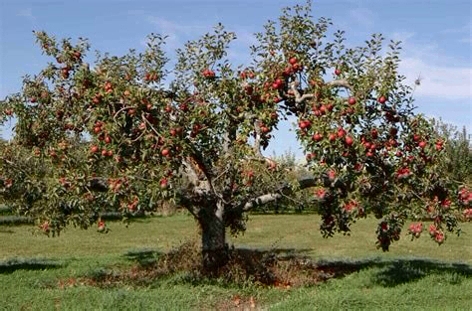
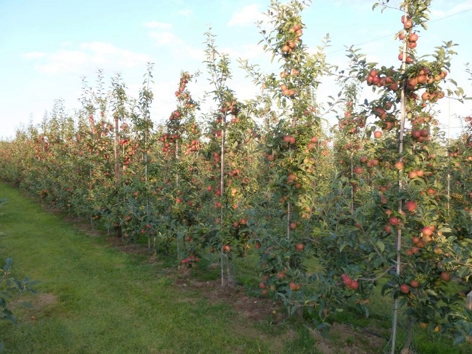
Thinning
'To thin or not to thin; that is the question!
Modern varieties are more likely to set a crop than our stalwarts of the past (Cox)
The number one (by volume) apple sold in the UK is Gala. This variety produces fruit bud on one year wood, which is very useful if the tree does not carry enough fruit bud on the older spur wood or has suffered frost damage on the early bloom. But if there is a surplus of fruit bud, growers will attempt to remove the bloom from the young wood. This is normally done with a sulphur spray which burns out the early flowers.
The optimum time for thinning is early: e.g. circa 12mm for internal fruit quality determined by 'dry matter content' which is also critical in optimising storage longevity and eating quality out of long term storage.
Thinning by Hand
When fruitlets set heavily (5+ per bunch) it is essential to reduce the numbers to no more than two per bunch. That may be too many, but if necessary the total fruit numbers per tree can be reduced during the summer.
Below: left. Unthinned and right thinned Red Devil fruitlets
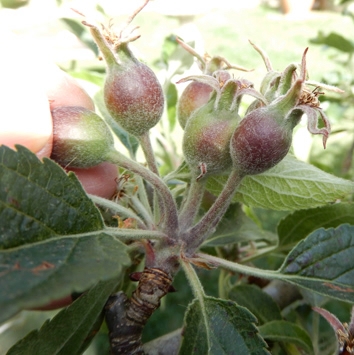
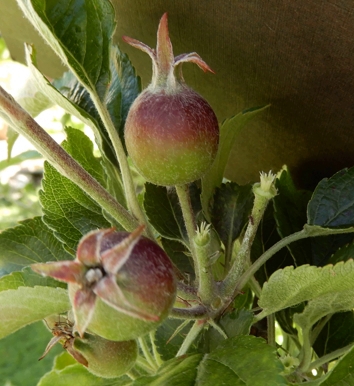
Always remove the King Fruit (the centre of the bunch) which is more likely to be of poor shape.
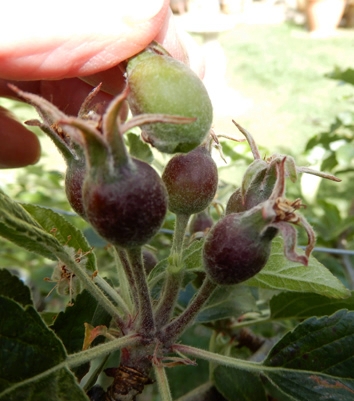
'Rosy Apple Aphid ' - Something to watch out for!
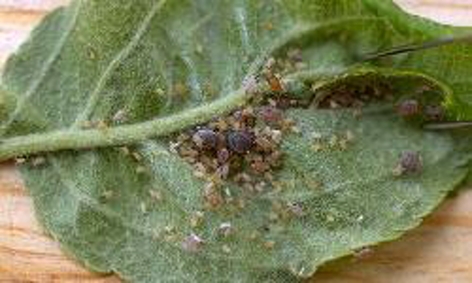
Rosy apple aphid is a small (2.5mm) dull pinkish or purple-grey sap-sucking insect that feeds on apple foliage and on fruitlets during spring and early summer. It causes leaves to curl and fruits can be distorted.
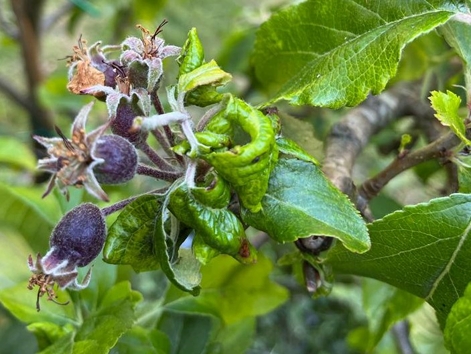
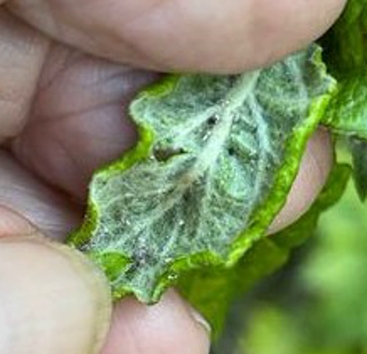
Aphids in general
Aphids are sap-sucking true bugs and are an important part of many food chains, supporting many predators. They range in size from 1 to 7mm (1/4 inch or less) long. Some aphids are known as greenfly or blackfly, but there are species that are yellow, pink, white or mottled. There are more than 500 aphid species in Britain. Some feed on only one or two plant species, but others can be found on a wide range of plant hosts. Almost any plant can be a host to aphids, including ornamentals, vegetables, fruits, greenhouse plants and houseplants.
Rosy apple aphid
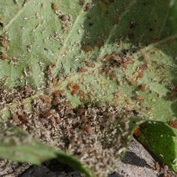
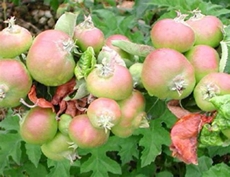 Dense colonies of slate and pinkish-grey aphids develop on the underside of the foliage in spring and early summer. Affected leaves at the shoot tips become curled and yellowish. Where the aphids have been sucking sap from the fruitlets, they prevent the fruits' normal development.
Dense colonies of slate and pinkish-grey aphids develop on the underside of the foliage in spring and early summer. Affected leaves at the shoot tips become curled and yellowish. Where the aphids have been sucking sap from the fruitlets, they prevent the fruits' normal development.
These fruits often remain small, with a pinched appearance around the eye end. In late summer, some branches may have normal fruits while others have only damaged fruits, reflecting the distribution of aphids on the tree earlier in the reflecting the distribution of aphids on the tree earlier in the growing season.
The period of time when an individual plant is in active growth. This will depend on the local climate and light levels, and can vary between different plants, although it is broadly from spring to autumn.
Heavily affected shoots show stunted growth with distorted leaves that start to turn brown during the summer. The main damage is to the developing fruits, which can be severely undersized and malformed.
Control
In home gardens not all fruit are usually affected and so some aphids can be tolerated. Aphids form the basis of many food chains and it is not unusual to have some of these animals in a healthy balanced garden ecosystem. Check apples frequently from spring onwards so action can be taken before a damaging population has developed.
On tall trees aphids can be considered part of the biodiversity they support, natural enemies will normally reduce numbers by late summer. In addition artificial treatments are only likely to be successful if the entire plant can be reached. When choosing management options you can minimise harm to non-target animals by starting with the methods in the non-pesticide control section and avoiding pesticides.
Within pesticides the shorter persistence products (that are usually certified for organic growing) are likely to be less damaging to non-target wildlife than those with longer persistence and/or systemic action. Pesticide treatments are likely to kill natural enemies and are only likely to be successful if the entire plant can be reached.
Non-pesticide control
Where possible tolerate populations of aphids, they form an important part of many food chains and can be part of a healthy garden ecosystem.
In garden situations - Use finger and thumb to squash aphid colonies where practical!
Encourage aphid predators in the garden, such as ladybirds, ground beetles, hoverflies, parasitoid wasps and earwigs. Be aware that in spring aphid populations often build up before natural enemies are active in sufficient numbers and then give good control
Some natural enemies can be purchased for use as biological control of aphids in greenhouses, including hoverfly larvae, lacewing larvae and several parasitoid wasps.
More information about these can be found on the RHS 'aphid predators' page.
The English Apple Man Comments
Crop set and apple thinning are relevant to garden apple trees as well as commercial orchards. Rosy apple aphids equally so.
To achieve regular crops of apples, trees must produce a sustainable yield. Too many fruitlets will 'stress the tree' leading to irregular cropping. The edible quality will also be improved by a balanced crop of well textured apples.
Rosy apple aphid can be devastating, "as seen on trees in the English Apple Man's garden" - always appearing on one variety each spring while none on other varieties in the same garden!
Vigilance is critical when the new leaf appears in spring time, once established it is difficult to erase!
![]() That is all for this week
That is all for this week
Take care
The English Apple Man